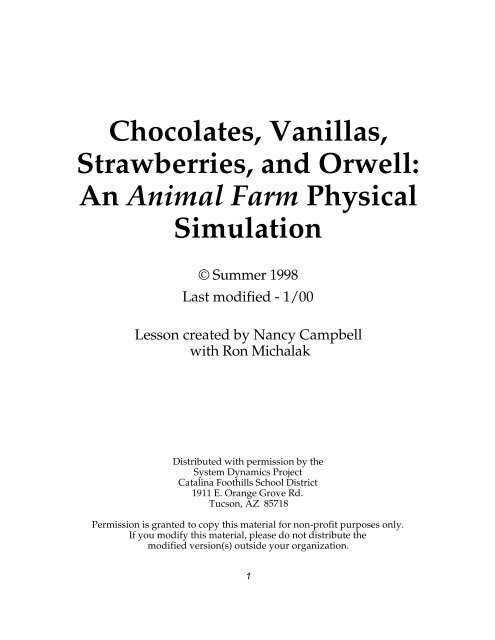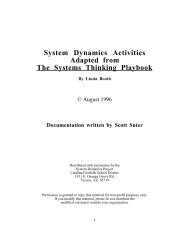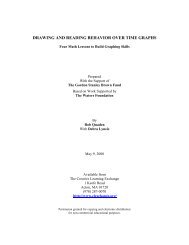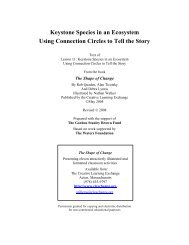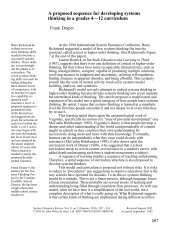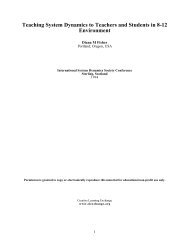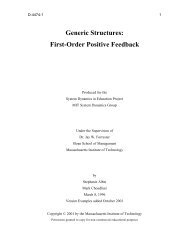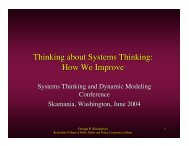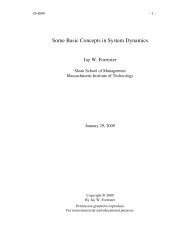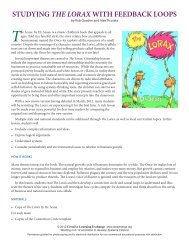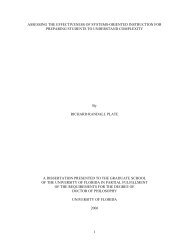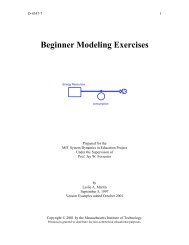An Animal Farm Physical Simulation
An Animal Farm Physical Simulation
An Animal Farm Physical Simulation
- No tags were found...
Create successful ePaper yourself
Turn your PDF publications into a flip-book with our unique Google optimized e-Paper software.
Chocolates, Vanillas,Strawberries, and Orwell:<strong>An</strong> <strong>An</strong>imal <strong>Farm</strong> <strong>Physical</strong><strong>Simulation</strong>© Summer 1998Last modified - 1/00Lesson created by Nancy Campbellwith Ron MichalakDistributed with permission by theSystem Dynamics ProjectCatalina Foothills School District1911 E. Orange Grove Rd.Tucson, AZ 85718Permission is granted to copy this material for non-profit purposes only.If you modify this material, please do not distribute themodified version(s) outside your organization.1
Grade Level: Seventh GradeChocolates, Vanillas, Strawberries, and Orwell:<strong>An</strong> <strong>An</strong>imal <strong>Farm</strong> <strong>Physical</strong> <strong>Simulation</strong>CFSD Curriculum: George Orwell’s <strong>An</strong>imal <strong>Farm</strong> is one of the novels selected forSeventh Grade Writing and Literature classes.Lesson Objectives:1. Following the simulation, students will be able to express, orally and in writing, theirfeelings and emotions as participants in an unfair and unequal system.2. Using behavior-over-time graphs, students will be able to graph the changes overtime in both the <strong>An</strong>imal <strong>Farm</strong> and “Chocolate” systems and will be able to make oraland/or written connections between the novel and the simulation.3. After reading the text, the students, through oral and written expression, will connectthe events of the novel to the Success to the Successful archetype.Activities at a Glance:1. The students, in prearranged groups, build windmills. They may only use thesupplies given to them. The groups will have unequal amounts of supplies. Thestudents build their windmills with the supplies given to them, as the teachermonitors behaviors, actions, and comments. Students should become upset asthey notice the unfair nature of this system. This lasts one 45 minute class period.2. Following the simulation, the students write their emotional responses to thesimulation in their journals. After a short discussion, the students graph, usingBOTGs, the different physical and emotional changes that occurred over the courseof the simulation. This debrief/processing part of the simulation should last one fortyfiveminute period. This serves as a set to the novel <strong>An</strong>imal <strong>Farm</strong>.3. Throughout the reading of <strong>An</strong>imal <strong>Farm</strong>, the students will be asked to use BOTGs toshow patterns and trends of change that occur in the novel.4. Following the completion of the novel, the students are introduced to the Success tothe Successful archetype. Through group work, discussion, and writing, the studentsmake connections, using the archetype, between the events of the novel andhistorical and current events. This follow-up activity should last two forty-five minuteclass periods.5. As a final to the unit, the students will write an essay connecting the events of thenovel to the simulation, the archetype, and the BOTGs.Time Allotment: The simulation will take two forty-five minute class periods (oneWriting/Literature block). The first period will be the actual simulation, the second period willbe the processing. The simulation should be used as a set, done before the students readthe novel. (Due to the tendency for high emotional responses, it is important that thedebrief take place in the same time block as the simulation.)The follow-up archetype discussion should take place after the novel has been read.It should take, again, about two forty-five minute class periods.2
Integration Areas: This would blend very well with Social Studies. The RussianRevolution, obviously, would be an excellent tie-in, but any study of tyranny and/orinequality would lend itself to this simulation.Materials needed for the lessonMaterials• Building supplies: Paper, tape, scissors, staplers, cardboard, ribbon, boxes, glue,paper tubes, poster board, crayons, rubber bands, twist-ties, butcher paper, etc.• Paper or plastic grocery bags for the supplies• Students will need journal/notebook paper and a pen/pencilMedia• overhead transparencies• overhead pensEquipment• overhead projector• video camera to film simulation (optional)Preparation1. The teacher needs to spilt the students into heterogeneous groups, based on classsize, that fall into three categories, chocolate, vanilla, and strawberry. For a class sizeof 25 to 30, six groups were made with two in each category. The teacher shouldconsider the personality and maturity level of these students as he/she splits theminto groups. For example, an emotionally disabled student should not be in theStrawberry group, the group that is treated most unfairly. Students who are betterequipped to handle stress will best thrive in this group.2. The desks should be moved into islands, with a back table serving as the “supplystore.” Tape cards to the desks that list the names of the students in the group.3. The teacher needs to gather all of the building materials prior to class and have themsorted into bags according to the three categories BEFORE the students arrive.4. The journal questions to which the students will respond should be written, butconcealed, on either the chalkboard or on an overhead transparency.Background InformationThe teacher should have a working knowledge of BOTGs and the Success to theSuccessful archetype. Daniel H. Kim’s Systems Archetypes, published by PegasusCommunications in 1992, does an excellent job of explaining the archetype.ActivitiesThe <strong>Simulation</strong>1. As the students enter the room, have them find their groups according to the cardstaped to the tables. The students, placed in six prearranged groups, will be askedto build a windmill. The teacher will explain that windmills play a pivotal roll in thebook <strong>An</strong>imal <strong>Farm</strong>. The students will be told that only the best windmill will get fullpoints and that the project is worth fifty points (this grading system is part of thesimulation and will not be used to determine any part of the students' actual grades).The students may only use the materials supplied to each group. Stress that thegroups cannot share materials. If the students want extra materials, they must sendONE representative to the “store,” where that person may request extra suppliesfrom the “store owner” (teacher).3
2. The student groups build their windmills. One teacher ”mans the store,” while theother teacher (systems mentor or parent volunteer) monitors the behaviors,comments, and actions of the students. Two groups are the “have” groups, calledthe “Chocolates.” They will have a surplus of supplies. The teachers will providethese groups extra supplies throughout the simulation. The “medium” two groups,called the “Vanillas” will have some supplies and will at times get extra supplies fromthe teachers. They will not, however, be given as much as the “Chocolates.” Thetwo “have-not” groups, the “Strawberries,” will have very little supplies. Theirsupplies may be given to the “Chocolate” group if they do not use them quicklyenough.3. The teacher should anticipate students to be protesting, stealing from other students,giving up, or bragging as they discover the inequality. After the students have hadtime to put their resources together, have the students present their windmills to theclass as the teacher “grades.” It is important that the teacher tells the students theirgrades in such a fashion that the entire class hears what each group earns. TheChocolates will get an “A,” the Strawberries get an “F” and the Vanillas will get a “C,”regardless of the windmills’ quality. NOTE*** The two teachers need to monitor theemotion level through out the simulation. If it looks as though students are getting tooupset, the teachers need to use their best judgments and cut short the simulation.The first time I did this simulation, one student started to cry because she thought itwas a real grade. Always keep the emotional well-being of the students the first andmost important priority.4. After explaining to the students that this is not an actual grade, ask the students totake out their journals and respond, in writing, to the following questions.1. How did you feel at the beginning of the activity? How did your feelingschange during the time of the simulation? Why do you think yourfeelings changed?2. Was this a fair activity? Would you rather be a chocolate, vanilla, or astrawberry? Why?5. After the students have had time to write, ask some of the students to share theirfeelings. Encourage many students to share, but make sure to not let this take morethan about 15 minutes unless another period is added.6. Briefly familiarize students with BOTGs if this is a new concept. Brainstorm in groupsconcrete (amount of materials, etc.) and abstract (level of frustration, anger, etc.)elements of the system. Have the students graph in their journals the changes overtime for one concrete and one abstract element of the simulation.7. Ask representatives of the different groups, Chocolate, Vanilla, and Strawberry, todraw their graphs on the chalkboard. Have the student explain his/her graph to theclass. The graphs should show a pattern—students with fewer resources havegreater frustration, anger, etc.8. After seeing the different graphs on the chalkboard, the students, in groups, willsummarize, in writing, the trends found in the different BOTGs. They should see thatthe Chocolate group is more successful, thus, happier.9. After a few students share the trends discovered, ask the students to determine thestructure of the simulation by seeing the patterns in the trends. What were the rules4
of the simulation that the teacher was following? Students should recognize that overtime, the Chocolates were given more supplies than they needed, the Vanillas weregiven barely what they needed, and the Strawberries were given less than theyneeded. Encourage students to look hard for these same trends as they beginreading <strong>An</strong>imal <strong>Farm</strong>.Reading <strong>An</strong>imal <strong>Farm</strong>During the reading of the novel, have the students use BOTGs to graph thechanges and trends which occur over time in the novel. This serves as a catalyst fordiscussion. Again, look for concrete and abstract trends to graph. Examples include level offear, frustration of the animals, Napoleon’s power, Napoleon's use of force, education,standard of living, ceremony, feelings of pride, etc.Follow-up Archetype Activity1. Now that the students have completed <strong>An</strong>imal <strong>Farm</strong>, have them return to theiroriginal groups (Vanilla, Chocolate, Strawberry) for a follow-up activity. Have thestudents look at their original BOTGs from the Chocolate simulation (in their journals).Using the same abstract and concrete elements of the system that they graphedearlier, the students should now create BOTGs from the perspective of the pigs, thedogs, and the other animals.2. Line up the BOTGs on the board. With the evidence in front of them, ask thestudents which animals from the text most represent the simulation groups.Students will likely say that the Chocolates were the pigs, Vanillas were the dogs,and Strawberries were the rest of the animals.3. Brainstorm with the students what resources the pigs had which made themsuccessful. Write these on the board as the students name them out. Brainstormalso what elements the other animals lacked (or were denied) which made them lesssuccessful. Students will likely come up with power, resources, and education.4. On the overhead, introduce the students to the Success to the Successfularchetype. (see attached) Explain how because the pigs (A) are given moreresources, they have a higher likelihood of succeeding than the other animals (B).<strong>An</strong>swer any student questions.5. Using the brainstormed topics off the board, assign each group a different elementof the system (education, law-making, etc.). Using this element, have the groupsdraw out the archetype on butcher paper. Tell the groups to be prepared to presenttheir archetypes.6. Have each group present their archetypes, answering questions from the studentsand teacher.7. Ask the students to write a response to the archetypes in their journals. Use thisquestion to get them started:How does this archetype apply to what we see in the newspapers, oursociety, or history?Have the students write for five minutes, then call on students randomly toshare their answers. Write down key points on the chalkboard. Encouragediscussion as the students make connections between the archetype and their lives.5
Success to the SuccessfulSSuccess ofARResourcesto ASSAllocation to Ainstead of BOOSuccess ofBRResourcesto BS7


